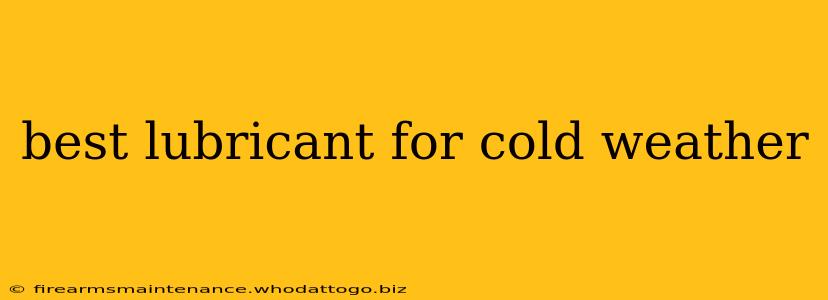Winter's icy grip can wreak havoc on machinery and equipment, causing sluggish performance and even damage if not properly lubricated. Choosing the right lubricant for cold weather is crucial for maintaining optimal functionality and preventing costly repairs. This comprehensive guide will delve into the factors to consider when selecting a lubricant for sub-zero temperatures and highlight some of the best options available.
Understanding the Challenges of Cold Weather Lubrication
Low temperatures significantly impact the viscosity (thickness) of lubricants. Most lubricants thicken as the temperature drops, making them less effective at reducing friction and wear. This increased viscosity can lead to:
- Difficult starting: Engines and other machinery may struggle to start due to the thick lubricant hindering movement.
- Increased wear: Insufficient lubrication leads to increased friction between moving parts, causing accelerated wear and tear.
- Component damage: Extreme cold and insufficient lubrication can result in seizing or breakage of components.
Key Factors to Consider When Choosing a Cold Weather Lubricant
Selecting the appropriate lubricant involves careful consideration of several factors:
1. Pour Point:
The pour point is the lowest temperature at which a lubricant will still flow. A low pour point is essential for cold weather applications, ensuring the lubricant remains fluid enough to lubricate effectively. Look for lubricants with a pour point significantly below the expected minimum temperature.
2. Viscosity Grade:
Viscosity refers to the thickness of the lubricant. Lower viscosity grades (like 0W-20 or 5W-30 for motor oil) are generally better suited for cold weather because they flow more easily at low temperatures. Check the lubricant's viscosity grade chart to ensure it's appropriate for your expected temperature range.
3. Additive Package:
Lubricants contain various additives to enhance their performance. In cold weather, additives that improve low-temperature fluidity, prevent wax crystallization, and provide anti-wear protection are crucial. Look for lubricants specifically formulated for cold weather operation.
4. Application:
The type of lubricant needed will vary depending on the application. Motor oil, grease, hydraulic fluid, and other specialized lubricants each have their specific requirements for cold weather performance. Choose a lubricant designed for its intended purpose.
Best Lubricant Types for Cold Weather Applications
Different applications necessitate different types of lubricants. Here's a look at some of the best options:
Motor Oil:
Synthetic motor oils generally perform better in cold weather than conventional oils due to their superior low-temperature fluidity. Look for oils with a 0W or 5W viscosity grade for optimal cold weather performance.
Grease:
Lithium-based greases are often a good choice for cold weather applications, offering good low-temperature performance. Specialty greases with added performance enhancers are also available for particularly harsh conditions.
Hydraulic Fluids:
Hydraulic fluids designed for cold weather operation typically have low pour points and enhanced flow properties at low temperatures. Check the manufacturer's specifications to ensure compatibility with your hydraulic system.
Maintaining Equipment in Cold Weather
Beyond choosing the right lubricant, proper maintenance practices are essential:
- Regular oil changes: Changing your oil regularly, especially during winter, helps ensure the oil remains clean and effective.
- Preheating engines: Allowing engines to warm up before operation helps reduce wear and tear.
- Proper storage: Storing lubricants in a warm, dry place prevents them from thickening or degrading.
Conclusion
Choosing the best lubricant for cold weather is crucial for maintaining the proper function and longevity of your equipment. By considering the factors discussed above and selecting a high-quality lubricant specifically formulated for low temperatures, you can ensure your machinery performs reliably even in the harshest winter conditions. Remember to consult the manufacturer's recommendations for your specific equipment to ensure optimal performance and avoid potential damage.

